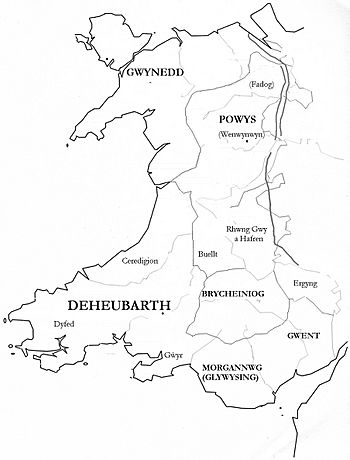Glywysing facts for kids
Quick facts for kids
Kingdom of Glywysing
Teyrnas Glywysing
|
|||||||||||
|---|---|---|---|---|---|---|---|---|---|---|---|
| 5th century–c. 1055 (intermittently in union with Gwent/in Morgannwg) |
|||||||||||

Medieval kingdoms of Wales, showing Glywysing in the south
|
|||||||||||
| Capital | Cardiff | ||||||||||
| Common languages | Old Welsh | ||||||||||
| Religion | Celtic Christianity | ||||||||||
| Government | Monarchy | ||||||||||
| Historical era | Middle Ages | ||||||||||
|
• Formed after Roman withdrawal from Britain
|
Late 5th century | ||||||||||
|
• Various unions with Gwent
|
6th century–c. 745 | ||||||||||
|
• Union in Morgannwg
(under Morgan Hen ab Owain) |
942–974 | ||||||||||
| 1055–1063 | |||||||||||
|
• Union in Morgannwg
|
1063–1074 | ||||||||||
|
• Becomes Morgannwg
(under Caradog ap Gruffydd) |
1075 | ||||||||||
|
|||||||||||
Glywysing was a small kingdom in south-east Wales during the Middle Ages. It existed from the time the Romans left Britain until around the 11th century. The people of Glywysing came from an ancient tribe called the Silures. This kingdom often joined with another kingdom called Gwent, and together they formed a larger area known as Morgannwg.
Contents
The Kingdom of Glywysing
Where Did the Name Glywysing Come From?
The kingdom of Glywysing is thought to be named after a ruler called Glywys. He was either a real king or a legendary figure from early times. His name might be linked to the Roman name *Glevenses, which referred to the area and people of Glevum (now Gloucester).
After Glywys died, his kingdom was divided into three smaller areas called cantrefs. These were named after his sons: Penychen, Gwynllwg, and Gorfynydd. Usually, one main family ruled all three cantrefs together. Sometimes, these areas were treated as smaller sub-kingdoms.
Where Was Glywysing Located?
The borders of Glywysing changed a lot over time. Generally, it was located between the Afon Llwyd river and either the River Loughor or the River Neath. Sometimes, it expanded eastward, joining with Gwent and Ergyng. By the year 928, the area of Gower had become part of Glywysing.
Today, the land that was once Glywysing is known as Glamorgan.
The Rise of Morgannwg
Glywysing often joined forces with the Kingdom of Gwent. When they united, the combined kingdom was called Morgannwg, or sometimes Gwlad Morgan. This name honored important kings named Morgan.
One of the first times this happened was under King Morgan the Generous (who lived around 630-730 AD). This union lasted until his descendant Ithel died around 745 AD. Later, King Morgan the Old (who ruled from 942-974 AD) also united Glywysing and Gwent. During these times, Glywysing and Gwent might have been like smaller parts of the larger Morgannwg kingdom.
After Morgan the Old died in 974, Gwent and Glywysing separated again. They remained separate until about 1055. However, Glywysing itself was often still called Morgannwg.
Around 1055, a powerful king named Gruffydd ap Llywelyn, who later became King of Wales, conquered both areas. But when Gruffydd died in 1063, Glywysing was taken back by its original ruling family under Caradog ap Gruffudd. The union of Morgannwg (Glywysing and Gwent) was then formed again. How this happened exactly is not fully clear. Perhaps the Kings of Glywysing were also Kings of Morgannwg, with the Kings of Gwent being semi-independent.
The Norman Conquest
As the Norman conquest of Wales progressed, the Normans began to take over Gwent. The last native king of Morgannwg and Glywysing was Iestyn ap Gwrgan (who ruled from 1081–1090). He was later removed from power by a Norman lord named Robert Fitzhamon.
Iestyn's sons became lords of the Afan area. Meanwhile, Owain ap Caradog ap Gruffudd became the lord of Gwynllwg and started the line of lords of Caerleon.
The name Morgannwg is still used in Wales today. It refers to the former area and county of Glamorgan, which is actually a changed version of the name Gwlad Morgan.
Important Rulers of Glywysing
Here are some of the key rulers who governed Glywysing throughout its history:
- Glywys (c. 470–c. 480): The king who gave his name to the kingdom. His sons ruled the three cantrefs:
- Gwynllyw (c. 480–523) in Gwynllwg
- Pawl (c. 480–540) in Penychen
- Mechwyn (c. 480–c.500) in Gorfynydd
- Cadoc (523–580): Son of Gwynllyw, he ruled Gwynllwg and Penychen.
- Rhys ap Ithel (c. 755–785): Ruled with his brothers.
- Arthfael Hen ap Rhys (785–c. 825): Known as Arthfael the Old.
- Hywel ap Rhys (c. 840–886).
- Morgan the Old (930–974): Also known as Morgan Hen. He united Glywysing and Gwent in 942, creating Morgannwg. However, the kingdoms separated again after his death.
- Rhydderch ap Iestyn (c. 1015–1033).
- Gruffydd ap Rhydderch (1033–1055).
- Gruffydd ap Llywelyn (1055–1063): An invader who became Prince of Gwynedd and King of Wales, conquering Glywysing.
- Caradog ap Gruffydd (1063–1081): Regained control of Glywysing after Gruffydd ap Llywelyn's death.
- Iestyn ap Gwrgan(t) (1081–1091): The last native ruler of an independent Morgannwg. After him, the Normans took control, and it became the lordship of Glamorgan.

